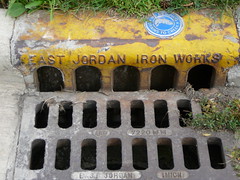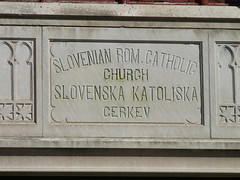Like every intellectual project, there are certain autobiographical tendencies in Global Heartland. I was raised in the midwest, and although I have lived in other parts of the US and have traveled to other parts of the world, I have spent most of my 40 years very close to the Great Lakes. The Lakes and the world that has grown up around them are my cultural home, and my spiritual anchor.
In less than a year, I will move far away from all of this to take a job in the History Department of a certain public university in Southern California. So this blog is a last chance to document my impressions of the midwestern landscape and culture before we move away, and inevitably it will be something of a nostalgia trip. Although I promise to keep the nostalgia level down, I don't think I can do this blog without periodic doses of personal history. So to keep it real, I will try to connect the personal to the global as much as possible, and so am introducing a posting category: everyday artifacts of globalization.
I spent about 10 summers in northern Michigan at a YMCA summer camp, first as a camper and then as an employee leading wilderness trips. As it happens, this camp was pretty close to East Jordan, Michigan, and I recall driving by the foundry there several times. So when I moved to Champaign, Illinois, in the early 1990s I immediately noticed that most of the storm drains were stamped "EAST JORDAN IRON WORKS," and it made me feel a little more at home.
Later, when I was writing my dissertation, I discovered that the sociologist who wrote the seminal work on transient workers, Nels Anderson, grew up near East Jordan, and his immigrant father worked in the foundry to supplement the income from the family's farm. The iron works was established in 1883, when northern Michigan's white pine forests were being clear cut by a largely immigrant workforce to supply the nation with telegraph poles and construction timber.
East Jordan was not a big town then, and it's probably smaller now. So I was very surprised to discover that the East Jordan Iron Works is a multinational corporation with foundries in Ireland, France, Brazil, and Asia, as well as in the American South. It found a market niche for cast iron--storm drains, meter boxes, etc.--and bucked the trend of the US steel industry, all the while maintaining its headquarters in a decidely out-of-the-way place.
All of this is to say that artifacts of globalizations past and present are literally right under our feet. More later.
Global | Local | Middle
Sunday, October 08, 2006
This exit: transnational communities!
A big buzz concept in globalization studies is the idea that the labor migrations associated with contemporary globalization have created "transnational communities" and identities. Migrants don't give up their home identities, but keep up contacts with the home country through telephone, email, tapes, what have you. And of course, they send back money. The exchange of emotional and material capital between home and away changes home too. Both ends of the migration are transformed into a new, transnational community.
Last week on our way back from a conference in Madison we got off the interstate in LaSalle, Illinois, where I took this photo of the Slovenian Catholic Church--vintage early 20th century. I've seen plenty of church facades like this one in Chicago. But it was remarkable to see this and about 10 other churches--mostly Catholic--in this small coal mining town on the Illinois River. It is a marker of how the global migration of the 19th and early 20th century reached even into the small town midwest. My friend Caroline Merithew wrote her dissertation on these towns and their immigrant communities. Where's the book, Caroline!
Last week on our way back from a conference in Madison we got off the interstate in LaSalle, Illinois, where I took this photo of the Slovenian Catholic Church--vintage early 20th century. I've seen plenty of church facades like this one in Chicago. But it was remarkable to see this and about 10 other churches--mostly Catholic--in this small coal mining town on the Illinois River. It is a marker of how the global migration of the 19th and early 20th century reached even into the small town midwest. My friend Caroline Merithew wrote her dissertation on these towns and their immigrant communities. Where's the book, Caroline!
Subscribe to:
Posts (Atom)


